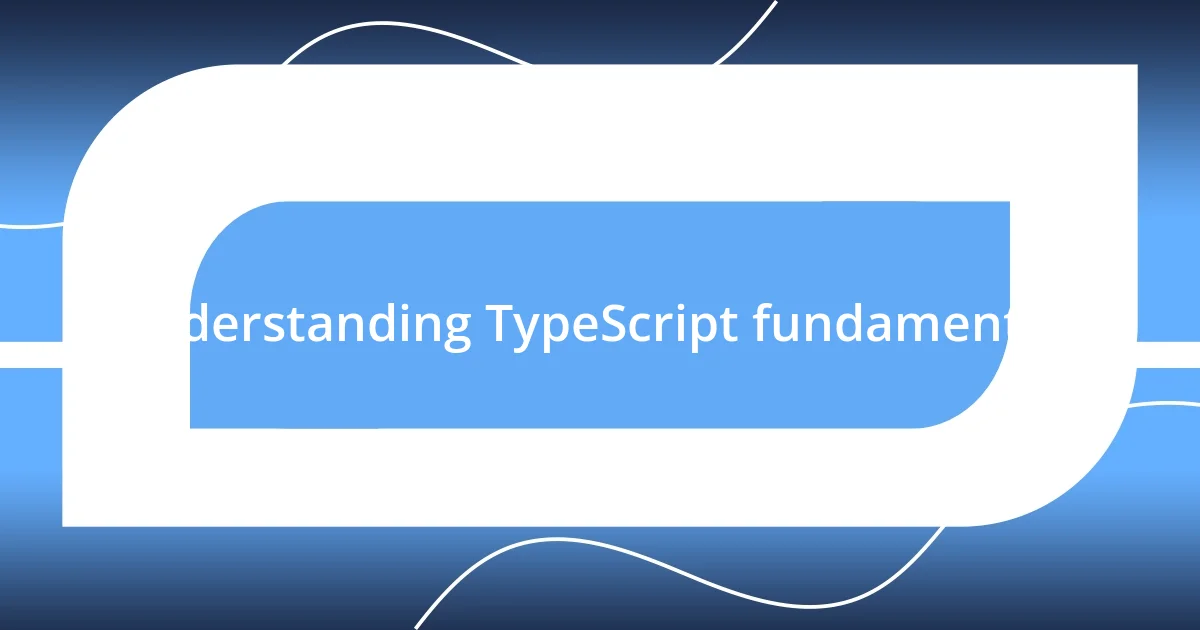Key takeaways:
- Understanding TypeScript fundamentals, such as static typing and interfaces, significantly enhances code clarity and maintainability.
- Common challenges include managing union types, grasping generics, and navigating type inference, which require careful consideration to avoid confusion and errors.
- Implementing best practices like defining clear interfaces, utilizing built-in utility types, and conducting regular code reviews fosters collaboration and improves overall code quality.

Understanding TypeScript fundamentals
Understanding the fundamentals of TypeScript can feel like a daunting task at first. I remember when I first delved into it; I was overwhelmed by the new types and syntax. However, the moment I grasped the concept of static typing, it clicked for me. Isn’t it fascinating how a simple idea like defining types can transform the way we write and understand our code?
Once I started experimenting with interfaces and type aliases, I discovered the power of TypeScript in creating cleaner, more maintainable code. There was a project I worked on where I refactored some JavaScript into TypeScript, and the clarity it brought to the codebase was striking. I often ask myself: how did I manage without it? This experience taught me that understanding these basics is not just a necessity but a gateway to better coding practices.
In my journey, I’ve also found that TypeScript’s strictness helps catch errors early. At one point, I faced a frustrating bug that would have taken hours to debug in plain JavaScript. With TypeScript’s type-checking, I resolved it in minutes. Have you ever experienced that sense of relief when your tools actually help you? Embracing these fundamentals has not only improved my coding efficiency but has made my programming journey far more enjoyable.

Common type-related challenges
TypeScript can present several type-related challenges that may trip up even seasoned developers. For example, one of the most common issues is dealing with union types. I remember tackling a particularly complex function where I had to allow multiple input types. It felt like trying to solve a puzzle, and I found myself constantly battling type mismatches. Union types can be a double-edged sword—while they offer flexibility, they can also lead to confusion if not managed correctly. Isn’t it interesting how the very feature designed to enhance our code can sometimes feel like an obstacle?
Another challenge I encountered frequently is the learning curve associated with generics. At first, I was intimidated. I spent hours wondering if I was using them correctly and how they would impact type safety. There was one specific case in a project where I had to create a reusable component, and I couldn’t get generics to work smoothly. This frustration made me appreciate the importance of understanding this concept better. I realized that once I wrapped my head around generics, they opened up a whole new level of code reusability and efficiency. It’s remarkable how addressing such challenges can lead to significant breakthroughs in our coding practices.
Finally, type inference can sometimes be a slippery slope. Often, I find myself questioning what TypeScript infers regarding my variables. There have been moments when I thought I could rely on implicit types, only to run into unexpected errors later on. This experience taught me that it’s essential to strike a balance between trusting TypeScript’s inference and being explicit with type annotations. Have you had similar experiences? I feel like we all go through that learning phase—where we understand that being thoughtful about types can save us from headaches down the road.
| Challenge | Description |
|---|---|
| Union Types | Flexibility vs. Confusion |
| Generics | Learning curve and reusability |
| Type Inference | Implicit vs. Explicit types |

Debugging issues in TypeScript
Debugging in TypeScript can sometimes feel like navigating a maze. I remember when I was deep in a project, and I encountered a perplexing type error that seemingly appeared out of nowhere. It was frustrating, and I spent what felt like hours sifting through lines of code, only to realize it stemmed from a subtle mismatch in types. The ability of TypeScript to pinpoint these issues early is a gift, but it can also challenge my patience. That moment taught me to maintain a steady focus during debugging sessions, recognizing that clarity often comes from distancing myself from my frustrations.
Here’s a quick rundown of some common debugging issues I’ve faced:
- Type Mismatches: Small errors can ripple through your code, causing unexpected behavior that can be time-consuming to trace.
- Missing Type Annotations: I learned the hard way that an implicit ‘any’ can lead to disaster; being explicit has saved me from embarrassing mistakes.
- Third-Party Libraries: Sometimes, using libraries without type definitions can create a mismatch in expectations, leading to puzzling errors during runtime.
Being mindful of these challenges while debugging can not only save time but also empower me to write better code. So, whenever I hit a wall, I remind myself that it’s all part of the learning journey.

Configuring TypeScript for projects
Configuring TypeScript for a project can often feel overwhelming at first. When I first started with TypeScript, I was surprised by the sheer number of configuration options available in the tsconfig.json file. It took a bit of trial and error to figure out which settings were best suited for my needs. One time, I found myself diving deep into options like strict mode, which enhances type-checking. I didn’t realize how much it would help catch errors early on, but it also led to a lot of refactoring. Have you experienced that moment when you wish you could just reset the config to get back to basics?
Building a TypeScript project means making choices about compiler options, and sometimes those choices feel like a tightrope walk. For instance, I recall struggling with the module option when I was trying to integrate a TypeScript build into a larger JavaScript-based application. It felt like a balancing act between managing compatibility and leveraging TypeScript’s features. Each decision can impact how seamlessly your project runs, so each one demands careful thought. I believe that developing a solid understanding of these configurations can save a lot of headaches in the long run.
Another challenge I faced was ensuring that my linting and formatting tools aligned with TypeScript’s requirements. Once, during a team project, we ran into massive inconsistencies because some teammates had different configurations. It surprised me how quickly things fell apart due to small differences in tool settings. Aligning our preferences improved not only our code quality but the collaboration experience as well. Does that sound familiar? Getting everyone on the same page can truly make or break a project.

Working with third-party libraries
Working with third-party libraries in TypeScript can be a mixed bag. I vividly remember the excitement of integrating a popular library into my project, only to discover it lacked proper type definitions. That realization was disheartening because without those definitions, every function call felt like a leap of faith. I found myself wrestling with the feeling of uncertainty—did I truly understand the library’s API, or was I just hoping for the best? This experience reminded me of the importance of thorough research before choosing a library.
There was one instance when I decided to use a library that promised to simplify a complex task. Initially, everything seemed great until I encountered an obscure error related to type incompatibility. It puzzled me for days. I realized that the library’s types didn’t align perfectly with TypeScript’s expectations. I learned to appreciate the need for community-maintained type definitions, which can either make or break the development experience. Have you ever wished for clearer documentation? Sometimes, a simple piece of information could have saved me countless hours, allowing me to focus on delivering value rather than troubleshooting.
Another challenge I faced was keeping third-party libraries updated. I remember one day when I updated several dependencies, and my project broke because of a major version change in one of them. It sent me spiraling into a rabbit hole of incompatibility issues—the dreaded version compatibility hell! I’ve since developed a habit of checking changelogs meticulously and using tools like npm audit to catch potential pitfalls before they become a headache. How do you navigate the landscape of library updates? Being proactive in managing library versions has become a crucial strategy for me in maintaining a smooth development workflow.

Best practices for TypeScript development
Implementing best practices in TypeScript development is essential to enhance code quality and maintainability. I quickly discovered that defining clear interfaces and types at the start of a project could save me from a lot of trouble down the line. I remember a project where I skipped this step and ended up dealing with cascading errors that took hours to untangle. Have you ever felt drowning in a sea of type errors that could have been avoided? Using interfaces made my code not only more readable but also more comprehensible for my teammates.
Another practice that I found invaluable was leveraging TypeScript’s built-in utility types. Initially, I was hesitant to dive into features like Partial<T> or Readonly<T> because they seemed overwhelming. However, once I started using them, I realized how they streamlined code and enhanced type safety. There was a moment when I transformed a convoluted object structure into something far more manageable and expressive. The clarity it provided was like a breath of fresh air, making me wonder why I didn’t embrace these tools sooner.
Lastly, regular code reviews became a cornerstone of my development practice. I learned firsthand how sharing insights and critiques with colleagues can elevate the entire team’s coding standards. During one feedback session, a teammate pointed out some areas where I could use more specific typing—this not only improved my work but also strengthened our collaboration. Have you had a similar experience where feedback opened your eyes to better practices? I genuinely believe that fostering an open dialogue about code leads to continual improvement and a more cohesive team effort.

Strategies for overcoming challenges
One effective strategy I’ve discovered for overcoming challenges in TypeScript development is to create custom type definitions when third-party libraries lack them. I remember a frustrating instance when I had to dive into the really cryptic documentation and try to reverse-engineer types myself. It felt like a treasure hunt! While tedious, this process helped me gain a much deeper understanding of the library’s structure and quirks. Have you ever found yourself in a similar predicament? It’s often worth it to invest that initial time to create typings; it pays off in the long run by making your code cleaner and more reliable.
Another tactic I’ve employed is developing a robust testing framework. When I first started using TypeScript, I often skipped writing tests, thinking they weren’t necessary for quick prototypes. However, after facing a cascading failure due to minor type mismatches, I quickly changed my tune. Now, I always write unit tests that not only validate the logic but also verify type behavior. It’s amazing how this practice boosts my confidence in my code. I often ask myself, “Can I trust this function to behave as expected?” And well, with a good suite of tests, I can say yes much more often.
Keeping my TypeScript code organized is another strategy that minimizes challenges. Initially, my files were a chaotic mix of components and utilities, and it felt overwhelming. One day, I decided to implement a module structure, categorizing my code into logical groupings based on functionality. This decision made it incredibly easy to navigate my projects. Have you ever felt lost in your own code? By maintaining organization, my development workflow has become smoother, and I can focus on building features rather than searching for files buried in a mess.












